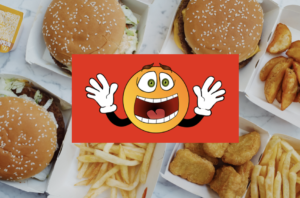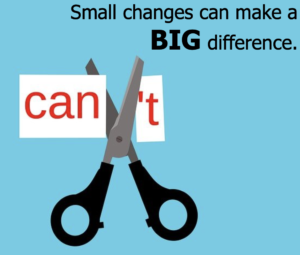Imagine this…
what if you were from outer space and just got dropped off here, landing smack dab in the middle of the country. After observing everything for a few weeks, your friends back home ask you to report on what you have found.
How would you describe the culture?
You might say things like:
- Everyone seems to be in a hurry – there are cars zooming around everywhere and people are really busy all of the time.
- People are always buying things! There are all these huge stores that are packed with people — they must have unlimited supplies of money!
- There are restaurants all over the place – people line up in their cars to get food delivered through their car window and sometimes even eat their food while they are driving.
- Everyone is always looking at these small rectangular devices. I thought maybe it was their way of reading books or following a map to their destination, but they are ALWAYS on them – sometimes even when they are eating together!
- These people must get sick a lot…there are hospitals and medical facilities everywhere and they spend over $4 trillion every year on healthcare! I can’t quite figure it out, where does all that money come from?!
Think about this for a minute, what are some other ways you would describe our culture?
 In last week’s coaching tip on consistency, we talked about one of the keys to success is making the healthy choice the easy choice. Unfortunately, in our culture, this is not as easy as it sounds.
In last week’s coaching tip on consistency, we talked about one of the keys to success is making the healthy choice the easy choice. Unfortunately, in our culture, this is not as easy as it sounds.
We are surrounded by fast food, vending machines, concession stands, and take-and-bake meals. Not to mention the advertisements and commercials, the candy bars in every checkout aisle, and the social media posts with people flaunting extra-large frappuccinos, maple bacon donuts, and monster cookies.
Obviously, all of this makes the UNHEALTHY choice the easy choice, and it can be super-challenging to consistently make healthy food choices.
So, why is culture important?
 There are many ways to define “culture.” One way is the attitudes, values, beliefs, and behaviors of a group of people that are passed from one generation to the next.
There are many ways to define “culture.” One way is the attitudes, values, beliefs, and behaviors of a group of people that are passed from one generation to the next.
The magic of Santa Claus is part of our culture that gets passed from generation to generation. We just celebrated New Year’s and resolutions are part of our culture, passed down to the new generations. The idea that money leads to happiness is part of our culture that seems to become engrained in so many people from every generation (whether it is true or not).
It’s important to remember that our culture affects our habits. If you are starting a new job at a new company, the first few meetings you go to, you will probably have your phone secured firmly in your pocket or bag. You don’t want to be “that person” on their phone during an important meeting. After the first few meetings, if you see others on their phones, eventually you are likely to pull out your phone just like everyone else. The behavior of it being acceptable to be on your phone during a meeting has now been passed on to you. And you are likely going to pass that behavior on to others. It is part of the culture!
How does food fit into this?
Back to our definition of culture, what if we ask ourselves, “what are the attitudes, values, beliefs, and behaviors we are passing from one generation to the next when it comes to food?”
Can you relate to any of these?
- As 5 o’clock rolls around, asking “what should we do for dinner?”

- Always having snacks like Goldfish crackers, Cheeze-Its, Doritos and Oreos on hand.
- Ordering pizza every Friday night? Or getting donuts every Saturday morning?
- Driving through a favorite fast-food restaurant or getting takeout most nights for dinner?
- Stocking up on frozen pizzas and soda for quick and easy meals at home?
- Celebrating every achievement with ice cream or cupcakes? Or maybe a team meal at McDonald’s?
- Post-game snacks for young kids, consisting of Gatorade and cosmic brownies to replenish the nutrients lost from the vigorous game?
- Donuts and juice after Sunday church service?
YIKES! What are we teaching our kids?! Will these behaviors and habits just keep going, generation to generation?! What if instead, we could have a “redo” or “reset?”
So, let’s start over!
What would be on your list of things that describe your food culture? What if, instead, the list looked something like this:
 Routinely roasting vegetables at home several times a week.
Routinely roasting vegetables at home several times a week.- A big, delicious salad with a homemade dressing every day!
- 8-10 servings of fruits and vegetables every day!
- Weekly meal at a local restaurant where they put their heart and soul into preparing their meals.
- Shopping at the farmers’ market and focusing on in-season produce.
- Grab-and-go breakfasts, snacks and sweet treats made from REAL ingredients!
Is it possible to change the culture?
Of course, changing the culture of our country or society can seem difficult and time-consuming. However, there are opportunities within our microculture (the culture of smaller communities and groups within our larger society) that can have a meaningful and rapid impact.
 Start at home!
Start at home!
Your home and your family can have its own culture. And this culture can be – and must be – intentionally shaped.
What are the attitudes, values, beliefs, and behaviors in your house that you want to be passed from one generation to the next? It’s not too late to change and make improvements, even when it comes to food!
Here are a few coaching tips that might help give you some inspiration, which include tips on planning, 2-for-1 meals, and healthy habits:
And Now…the Rest of the Story…
It’s Not You, It’s Our Environment…
What Can a Nobel Prize Winner Teach Us About Eating Healthy?
One thing at a time!
As you make progress in the desired culture in your home, you will gain confidence to make changes to other microcultures outside of your home, such as your workplace, in your kids’ schools and other activities, and in your social circles.
Over the next few weeks, we will share tips on how to try to create positive change in those environments!
We would love to hear your thoughts!
What are specific challenges you would like help conquering?
Tell us in the comments and let’s talk about it!
 LEARN MORE ABOUT THE NAPKIN!
LEARN MORE ABOUT THE NAPKIN!





My kiddo and I spent some time talking about food over the last couple days. We agreed that we want our approach to be:
– Eating as much home-cooked food as possible, limiting processed and restaurant food
– Listening to our bodies to determine what and how much food they need
– Eating as many fruits and vegetables as we can
– Not vilifying any particular food or drink
The challenge in all of this is that my kid does not like many things that I do (especially fruits and vegetables) and tends to go in cycles where he will want the same thing (and only that thing) for long periods of time.
We are a work in progress.
My challenge is in multiple directions.
1. I need simple menus, especially for breakfast and lunch. But I also like variety in food, and food that tasted good.
2. Often my plans get interrupted by friends and family
I do not like to tell my family and friends that I cannot do something because of my diet
3. I cave in when eating out, which is not often.
4. I live in a over 55 area, 6 months of the year. And they have donuts, cookies, popcorn (the packaged kind) at every event and meeting. Sometimes I can manage without, sometimes not, sometimes I bring my own and get looks.
I know these can all be conquered, one at a time.
5. My husband doesn’t always like my healthier foods.
Would like more ideas for protein packed lunches, I get hungry during the day, for busy working folks. I try not to do the grab & go fast food route but I am bored. Also quick meals for weeknights. Thanks.
This is a big and important piece of food, health, and community that’s often neglected. Thanks for bringing it to attention!